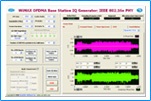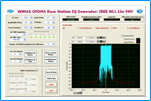|
|
|

|
|
802.16e BS & MS Receiver
Testing |
Overview
The SeaMAX Mobile BS (Base Station) IQ generator is the industries low
cost solution for Mobile WiMAX equipment and chipset manufacturers,
Test Houses, R&D and Academia. SeaMAX Mobile BS IQ generator creates
IEEE 802.16e compliant PHY signals required for testing the receiver
functionality of Base stations.
SeaMAX Mobile BSIQ generator includes the basic and advanced features
to generate WiMAX complaint signals.
The SeaMAX Mobile BS IQ signal generator creates IQ data for the Base
Station. The signal generator is used to check the performance of base
station receiver. It supports the DL subframe characteristics of a
generated signal and creates ideal (distortion free) or impaired test
signals for analysis purposes.
With the configuration options, the user can specify custom DL Burst
profiles, a number of MSs, and the impairments for the signal.
Easily create signals to evaluate the performance of your radio
designs, and the components that comprise them, under various
parametric and functional test conditions at baseband, RF and
microwave frequencies.
Features
SeaMAX Mobile BSIQ generator includes the basic and advanced features
to generate WiMAX complaint signals.
|
|
|
|
Standards Supported |
|
|
|
|
|
IEEE 802.16e-2005
OFDMA PHY |
|
|
|
|
Zone type supported |
|
|
|
|
|
PUSC |
|
|
|
|
FFT sizes |
|
|
|
|
|
2048, 1024,
512,128 |
|
|
|
|
Cyclic prefix values |
|
|
|
|
|
1/4, 1/8, 1/16,
1/32 |
|
|
|
|
Bandwidths |
|
|
|
|
|
1.25, 3.5, 5, 7,
8.75, 10, 14, 17.5, 20, 28 MHz. |
|
|
|
|
Modulation formats |
|
|
|
|
|
BPSK (Pilots only) |
|
|
QPSK |
|
|
16QAM |
|
|
64QAM |
|
|
|
|
Data payload types |
|
|
|
|
|
User defined
|
|
|
Text |
|
|
Predefined |
|
|
PRBS |
|
|
|
|
Frame configuration for Base Station |
|
|
|
|
|
PN index |
|
|
0 to 113 |
|
|
|
|
DL
ratio |
|
|
|
|
|
50% to 75% |
|
|
|
|
Sub channel bitmap |
|
|
|
|
|
User configurable |
|
|
|
|
DLMAP
repetition factor |
|
|
|
|
|
1,2,4,6
|
|
|
|
|
MAP Type |
|
|
|
|
|
Compressed/Normal |
|
|
|
|
Graphical utilities |
|
|
|
|
|
Print |
|
|
Zoom |
|
|
Set Markers and
change the appearance of plot |
|
|
Color |
|
|
Line style and
thickness |
|
|
|
|
|
|
|
|
|
|
|
DL
burst configuration fields |
|
|
|
|
|
No. of DL Bursts
|
|
|
Modulation-Code
rate |
|
|
OFDMA symbol
offset |
|
|
Sub channel offset |
|
|
Boosting |
|
|
No. of OFDMA
symbols |
|
|
No.of Sub channels |
|
|
Repetition Coding
Factor |
|
|
Data payload type |
|
|
Payload Length
(bytes) for each DL Bursts |
|
|
|
|
UL
burst configuration fields |
|
|
|
|
|
No. of UL Bursts
|
|
|
CID |
|
|
Code rate |
|
|
Duration in OFDMA
slots Repetition Coding Factor for each UL bursts |
|
|
|
|
Segment |
|
|
|
|
|
0, 1, 2
|
|
|
|
|
UL_permbase |
|
|
|
|
|
0 to 69 |
|
|
|
|
Uplink burst configuration fields |
|
|
|
|
|
No. of UL Bursts
(one) |
|
|
OFDMA symbol
offset |
|
|
Sub channel offset |
|
|
Symbols in UL zone |
|
|
Number of UL slots |
|
|
Modulation
Type-Code Rate |
|
|
Repetition factor |
|
|
Data Payload type |
|
|
Payload Length
(bytes) for each UL Bursts. |
|
|
|
|
Parameter display |
|
|
|
|
|
Sampling frequency
(Hz), Delta F (Hz) |
|
|
Segment |
|
|
Allocation start
time (Sec) for downlink subframe and OFDMA |
|
|
symbol time
|
|
|
Sub carrier
spacing, sampling frequency |
|
|
Number of used
carrier for uplink sub frame. |
|
|
|
|
Plots |
|
|
|
|
|
IQ (combined IQ
plot/Separate I and Q Plots) |
|
|
Transmit power |
|
|
CCDF |
|
|
Constellation
diagram |
|
|
Power Spectrum
with mask and 2D Frame view |
|
|
|
|
Impairments |
|
|
|
|
|
AWGN |
|
|
Frequency offset
|
|
|
Mobile Channel
Model |
|
|
|
|
Saving data |
|
|
|
|
|
Save IQ data
in.txt format for base station generated frame & Mobile
Subscriber generated ranging/data frame |
|
|
|
|
IQ Plot of the
Downlink Signal

Figure 1 |
Power Spectrum
Symbol Plot of the Downlink Frame

Figure 2 |
|
|
|
|
Request quote or Information
|
|
|
|